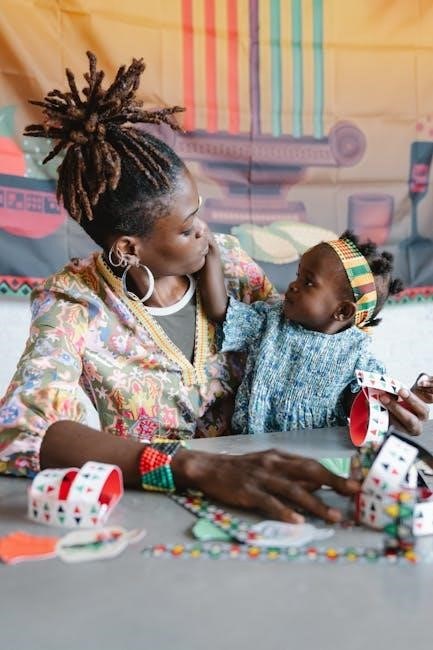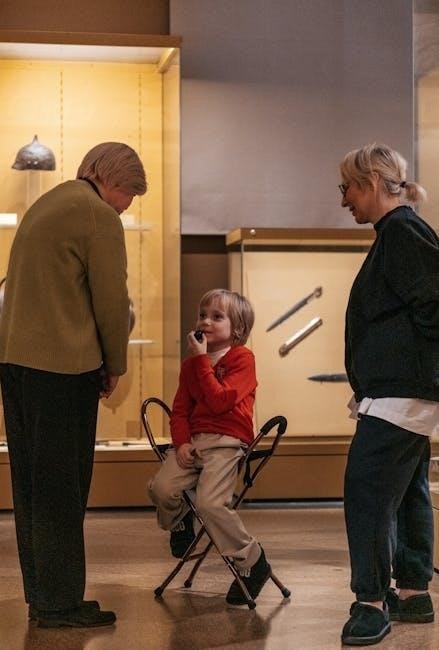Welcome to the “Arthur the King Parents Guide,” a resource designed to help parents navigate the themes and content of the beloved show. This guide provides insights into the series, focusing on its suitability for children and its educational value.
1.1 Overview of the Guide
This guide is designed to provide parents with a comprehensive understanding of the Arthur the King series, focusing on its content, themes, and suitability for children. It offers insights into the show’s structure, its target audience, and the key messages conveyed through its storylines. The guide also highlights the educational and developmental benefits of the series, making it easier for parents to decide whether it aligns with their child-rearing values. By breaking down the show’s elements, this resource serves as a tool for fostering meaningful conversations between parents and their children. It emphasizes the importance of media literacy and how parents can use Arthur the King as a platform for teaching life lessons. With a focus on practical advice, this guide aims to empower parents to make informed decisions about their child’s viewing habits.
1.2 Importance of Parental Involvement
Parental involvement is crucial when introducing children to media like Arthur the King. By engaging with the content, parents can guide their children’s understanding, ensuring they grasp the show’s positive messages. Active involvement helps parents address any questions or concerns their child may have, fostering a deeper connection. It also allows parents to reinforce the show’s lessons on empathy, friendship, and resilience. Moreover, discussing the series with children encourages critical thinking and helps them develop media literacy skills. Parents play a vital role in shaping their child’s viewing experience, making it both enjoyable and educational. By taking an active interest, parents can ensure that Arthur the King serves as a tool for growth and learning, aligning with their child’s developmental needs. This involvement not only strengthens the parent-child bond but also enriches the overall impact of the show.

Understanding “Arthur the King”
Arthur the King is an animated series that follows the adventures of a young boy named Arthur in the magical kingdom of Camelot. The show blends humor with heartfelt stories, exploring themes of friendship and growing up in a way that’s both entertaining and educational for young viewers.
2.1 The Premise of the Show
Arthur the King revolves around Arthur, a young boy who becomes the ruler of Camelot after pulling the legendary sword Excalibur from a stone. The series follows Arthur as he navigates the challenges of leadership, learning to balance his kingly duties with the typical experiences of childhood. Set in a magical kingdom, the show features a blend of mythical creatures, wizards, and knights, creating a rich and imaginative world. Arthur is supported by his friends, including Merlin the wizard, Guinevere, and other companions, who aid him in his quests and personal growth. Each episode often presents Arthur with a new dilemma, whether it’s resolving conflicts among his subjects, facing magical threats, or dealing with the pressures of growing up. The show’s premise emphasizes the importance of courage, wisdom, and compassion, offering valuable lessons for young viewers while maintaining an engaging and entertaining narrative.
2.2 Key Themes and Messages
Arthur the King explores several key themes that are essential for children’s development. Leadership and responsibility are central to the series, as Arthur learns to navigate the complexities of ruling Camelot. The show emphasizes the importance of honesty, loyalty, and fairness, often highlighting the consequences of one’s actions. Friendship and teamwork are also prominent, as Arthur relies on his companions to overcome challenges. Additionally, the series addresses emotional intelligence by portraying characters dealing with jealousy, fear, and self-doubt, offering relatable scenarios for young viewers. The show also touches on the idea of growing up and adapting to change, as Arthur transitions from a carefree boy to a wise leader. These themes are presented in a way that is both entertaining and educational, making Arthur the King a valuable resource for teaching children important life lessons while keeping them engaged with its magical and adventurous storyline.

Target Audience
The show primarily targets children aged 4 to 12, offering engaging storylines and relatable characters. It is designed to be family-friendly, allowing parents to enjoy the series alongside their kids while addressing age-appropriate themes.
3.1 Recommended Age Groups
The show is most suitable for children aged 4 to 12 years old; Younger children benefit from its colorful animation and simple storylines, while older kids can relate to the relatable characters and real-life situations. Parents should consider their child’s developmental stage and sensitivity when introducing the series, as some episodes tackle complex emotions and challenges. The content is generally mild, making it appropriate for family viewing. However, parental discretion is advised for younger viewers who may need guidance in understanding certain themes. Overall, “Arthur the King” is a timeless series that appeals to a broad age range while maintaining its educational and entertainment value for children.
3.2 Developmental Considerations
When considering “Arthur the King” for your child, it’s important to evaluate how the show aligns with their developmental needs. The series excels in addressing various aspects of child development, including emotional intelligence, social skills, and cognitive growth. Themes like friendship, empathy, and problem-solving are woven into storylines that help children navigate real-life challenges. For younger viewers, the show’s colorful visuals and engaging characters can enhance their attention span and curiosity. Older children can benefit from its nuanced exploration of complex emotions and moral dilemmas, fostering deeper thinking and maturity. Parents should be mindful of their child’s sensitivity levels, as some episodes tackle difficult topics like bullying or loss. Overall, “Arthur the King” is designed to support healthy development, making it a valuable resource for children’s growth;

Key Themes and Messages
“Arthur the King” explores central themes like social skills, emotional intelligence, and the challenges of growing up, offering positive messages about friendship, empathy, and self-awareness to help children navigate life’s complexities.
4.1 Social Skills Development
Social skills development is a cornerstone of “Arthur the King,” as the series portrays how Arthur and his friends navigate relationships, conflicts, and group dynamics. The show emphasizes the importance of communication, empathy, and cooperation. Characters often face challenges that require them to resolve disagreements, share responsibilities, and understand others’ perspectives. For instance, Arthur learns to balance his own needs with those of his friends, demonstrating how to compromise and maintain harmony. These interactions provide children with practical examples of how to interact positively with peers. Additionally, the series highlights the value of teamwork, showing how collaboration leads to successful outcomes. By observing these dynamics, children can develop essential social skills such as active listening, problem-solving, and conflict resolution. The show’s relatable scenarios make it easier for young viewers to apply these lessons to their own lives, fostering healthier interpersonal relationships and a stronger sense of community.
4.2 Emotional Intelligence
Emotional intelligence is a key theme in “Arthur the King,” as the series explores how characters recognize, understand, and manage their emotions. Arthur and his friends frequently experience a range of feelings, from excitement and joy to sadness and anger. The show teaches children to identify and articulate their emotions, helping them develop self-awareness and self-regulation skills. For example, Arthur often reflects on his feelings after facing challenges, demonstrating how to process emotions constructively. The series also highlights empathy, encouraging children to consider others’ feelings and perspectives. Characters like Buster and Francine show vulnerability, allowing children to see that it’s okay to express emotions and seek support. These storylines provide valuable lessons on emotional intelligence, helping kids build resilience and stronger relationships. By portraying realistic emotional experiences, “Arthur the King” equips children with tools to navigate their own emotional journeys effectively.

4.3 Friendship and Relationships
Friendship and relationships are central to “Arthur the King,” offering valuable lessons for children about building and maintaining strong, healthy connections. The show portrays diverse friendships, highlighting teamwork, empathy, and mutual respect. Arthur and his friends, such as Buster, Francine, and the Brain, navigate challenges together, demonstrating loyalty and support. These relationships often involve conflicts, but the resolutions emphasize understanding and compromise, teaching children how to handle disagreements constructively. The series also explores different types of relationships, such as family bonds and peer interactions, showing how each plays a unique role in emotional and social growth. By depicting realistic and relatable interactions, “Arthur the King” helps children develop skills to form and sustain meaningful friendships. Parents can use these storylines to discuss the importance of kindness, communication, and empathy in relationships, reinforcing positive social behaviors and emotional well-being. The show’s focus on friendship makes it a powerful tool for teaching children how to connect with others and build lasting relationships.
4.4 Growing Up and Change
Growing up and change are recurring themes in “Arthur the King,” offering children a relatable and reassuring perspective on the challenges of maturation. The series explores physical, emotional, and social changes that characters experience as they navigate childhood and adolescence. Arthur and his friends face issues like starting at a new school, dealing with puberty, and coping with family transitions, all of which are portrayed with sensitivity and humor. The show emphasizes that change is a natural part of life and that it’s okay to feel uncertain or overwhelmed. Through these storylines, children learn to embrace growth and adapt to new circumstances. The series also highlights the importance of resilience and the value of seeking support from friends and family during times of transition. By addressing these universal experiences, “Arthur the King” helps children develop a positive outlook on growing up and equips them with tools to handle life’s inevitable changes. Parents can use these episodes to spark conversations about personal growth and the emotional aspects of development.

Diverse Characters
The show features a diverse cast of characters with unique backgrounds, personalities, and abilities, reflecting real-world differences and promoting understanding and acceptance of others, helping children appreciate different perspectives and fostering empathy effectively.
5.1 Character Profiles

The characters in Arthur the King are thoughtfully crafted to represent a variety of backgrounds, personalities, and experiences. Arthur, the relatable protagonist, navigates everyday challenges with humor and heart, making him a character many children can identify with. His friends, including Buster, Francine, and the Brain, each bring unique traits to the group, showcasing diversity in interests, cultures, and ways of thinking. Even adult characters, like Mr. Ratburn, are well-developed, offering guidance while also revealing their own quirks and vulnerabilities. The show’s character profiles are designed to promote empathy and understanding, allowing viewers to connect with a wide range of personalities and situations. By highlighting these differences, the series encourages children to appreciate individuality and build stronger relationships with others. Parents can use these character profiles as a tool to discuss important social and emotional lessons with their kids.

5.2 Positive Role Models
The characters in Arthur the King serve as positive role models, offering valuable lessons for children. Arthur, the main character, embodies relatability and resilience, often learning from his mistakes and growing as a result. His friends, such as Buster and Francine, also showcase important traits like empathy, perseverance, and kindness. These characters demonstrate how to navigate challenges, resolve conflicts, and support one another, fostering a sense of community and mutual respect.
The adult characters, including Arthur’s parents and teachers like Mr. Ratburn, provide guidance and encouragement, modeling responsible behavior and a commitment to helping others. The show highlights the importance of honesty, inclusivity, and standing up for what is right, making the characters role models for young viewers. Parents can use these examples to discuss the value of positive behavior and its impact on relationships and personal growth.
- Arthur and his friends teach empathy and problem-solving skills.
- Adult characters model responsible behavior and kindness.
- The series promotes honesty, inclusivity, and standing up for what is right.
These role models help children develop a strong moral compass and understand the importance of treating others with respect and kindness.

Educational Value
Arthur the King is an excellent educational tool, teaching children valuable skills like problem-solving, critical thinking, and social awareness. It encourages learning through relatable stories and character development, making it a great resource for young viewers.
6.1 Academic Learning

Arthur the King enhances academic learning by incorporating various subjects like math, science, and reading into its storylines. The show often features characters solving math problems, conducting simple science experiments, or engaging in reading activities. These moments are woven naturally into the narrative, making learning feel fun and accessible. For instance, Arthur and his friends might use math to solve a puzzle or science to understand a natural phenomenon. The series also promotes critical thinking and curiosity, encouraging children to ask questions and seek answers. By presenting these concepts in a relatable and entertaining way, Arthur the King helps children develop a strong foundation for academic success. Additionally, the show’s focus on problem-solving and creativity reinforces skills that are essential for lifelong learning. Parents can use these episodes as a tool to discuss academic topics with their kids, making the learning process a shared and enjoyable experience. The blend of education and entertainment makes Arthur the King a valuable resource for children’s intellectual growth. The show also subtly introduces cultural and social lessons, broadening children’s understanding of the world. Its approach to failure and perseverance further highlights the importance of resilience in academic pursuits. Overall, Arthur the King is a great way to make learning both fun and meaningful for young viewers.